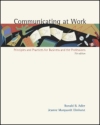Exercise 1 Goal: This activity is designed to help students apply the concepts related to a formal communication network
and determine the organization's strengths and weaknesses related to the way in which they communicate to people online. Instructions: Your task is to find one commercial and one non-profit organization on the Web and read about both of them.
After you have thoroughly explored the organization's Web page, you should attempt to create an organizational
flow chart that represents the formal communication network that you see. As you create these two flow charts,
consider the following questions: a) Can you get an accurate picture of an organization by looking at its Web page? b) Based on your research, are their differences in the way commercial and non-profit organizations communicate? Exercise 2 Goal: This activity is designed to help students recognize how important
effective communication skills are as they identify how pervasive the principles of communication are in today's business world. Instructions: Go to the business section of the New York Times website
<www.nyt.com> and select an article that you find interesting.
As you read, your task is to locate as many of the communication principles or axioms that appear to be a part of the story.
Be prepared to explain specifically why you believe that some particular part of the
story is evidence of one of the principles of communication discussed in this chapter.
For example, if you are reading a story that talks about the importance of effective communication,
does the axiom that "communication is a panacea" help explain all or part of the article? | 


 2002 McGraw-Hill Higher Education
2002 McGraw-Hill Higher Education